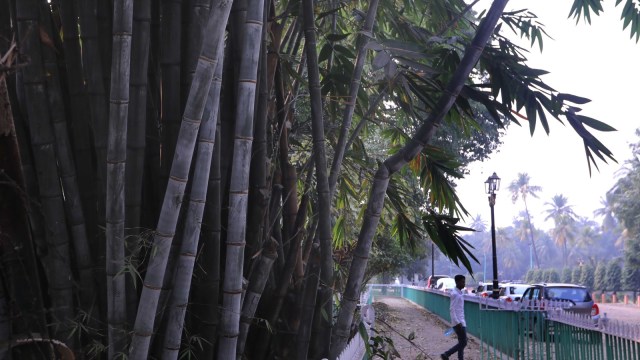The ‘burning era’ has begun: Chairman of Atal Bamboo Samruddhi Yojna on climate change
Atal Bamboo Samruddhi Yojna is a vital scheme launched to effectively combat the challenges of rising temperatures due to climatic change, according to Pasha Patel.
 Under the scheme, bamboos will be planted on 10,000 hectares of land across the state. (Express photo by Partha Paul/File)
Under the scheme, bamboos will be planted on 10,000 hectares of land across the state. (Express photo by Partha Paul/File)The Maharashtra government in its 2024-25 budget announced Atal Bamboo Samruddhi Yojna. The decision was taken after year-long deliberation that led to the constitution of a task force under CM Eknath Shinde. In an interview with Shubhangi Khapre, the executive chairman of the task force, Pasha Patel, reveals bamboo plantations have a larger role in not just tackling climate change but also boosting the rural economy in Maharashtra.
What is Atal Bamboo Samruddhi Yojna?
Atal Bamboo Samruddhi Yojna is a vital scheme launched to effectively combat the challenges of rising temperatures due to climatic change. For the first time, such an exhaustively studied scheme finds its way into the state’s annual budget 2024-25. Under this scheme, bamboos will be planted on 10,000 hectares of land across the state. In tribal Nandurbar district, bamboo plantation will be done over 1.20 hectares of land. The farmers will be given Rs 7 lakh over three years for the plantation and maintenance of the bamboos. 90 per cent of the scheme will be funded by the central government, while the remaining 10 percent will be covered by the state. In tribal areas, it will be entirely centrally funded.
How does tree plantation combat climate change?
The era of temperature rise is now over. Now, the “burning era” has begun which if not checked with quick measures, poses a threat to wreak havoc on humanity. To achieve these targets we have to minimise the use of diesel, petrol and coal. Simultaneously, we have to undertake massive tree plantations. On January 3, 2024 CM task force was constituted comprising nine cabinet ministers. On March 12, 2024 another task force under me along with 14 secretaries from various related departments was set up to take forward the project.
Why bamboo?
Bamboo is environmentally and economically feasible. Within three years of sapling plantation, it grows into a full fledged plant. Whereas, if we plant Peepal or Banyan trees, it takes over 10 to 15 years to grow into a tree. Secondly, bamboo annually generates 280 kg of oxygen and absorbs 320 kg carbon dioxide. If you plant bamboo along the roadside, house or any dwellings, the temperature will drop by two percent. It has been tested and proved.
Are bamboo economically lucrative to farmers?
Bamboo plantation is not going to replace traditional farming. Those who grow soybean, cotton, onion, etc will continue with their traditional framing. In addition to their traditional farming, we are encouraging farmers to take up bamboo plantation along their farm fences or river, pond banks.
Can you explain how the endeavour helps even the non-agriculture sector?
Maharashtra is soon coming out with an industrial policy where bamboo plantation and its production will become an integral aspect. The industries minister Uday Samant is working on it with our task force. Apart from environmental concerns, we are looking at its multiple utility, especially in giving impetus to the rural economy. The bamboo can be used to grow vegetables, make pickles, jams, grow rice, ethanol production, cloth, cutlery. Apart from that, the bamboo furniture industry can be fully developed through MSMEs. It has huge potential to generate employment and promote craftsmanship among skilled workers.
But it has its limitations as products, does it not?
Look we have to come out with alternatives to minimise the use of our existing resources mainly coal, iron etc to secure our environment. The alternative is in bamboo. It is a serious issue. The Dutch Finnish and Indian governments are all committed to bamboo cultivation. We have to reduce our dependence on thermal plants for power generation. Bamboo can be an alternative to biomass with higher calorific value. We are planning for 300 bamboo based refineries. The centre has already set up one refinery in Assam.
How does it guarantee employment in rural areas?
The centre has incorporated bamboo plantation under the Mahatma Gandhi National Rural Employment Guarantee Act (MGNREGA). So, bamboo plantation undertaken in the rural belt promises assured daily wages to the unemployed.
If our project evolves, its impact will be seen across rural and urban areas in terms of jobs and livelihood. To cite one example, the interior designing of Guwahati airport is done with bamboo. Similarly in Kempegowda airport, Bangalore. The chief minister Eknath Shinde has taken the decision to use bamboo in the interior design of Shirdi International Airport.
What about soil health and water requirements for bamboo cultivation?
This is one plant which can grow across the country, from Kashmir to Kanyakumari. It does not require much maintenance. It is less water intensive. Sugarcane crop on one hectare requires two crore litres of water. Compared to this, bamboo on one hectare needs only 20 litres of water. It survives on drip irrigation and 3.5 feet soil. From one ton of sugarcane crushing we make 80 litres ethanol. Whereas, one ton of bamboo processed generates 200 litres of ethanol.
How about drought prone region Marathwada?
If there is any region which will derive maximum benefit from bamboo plantation, it is the drought prone district of Marathwada. Before taking charge of the task force, I, myself, have worked in the field for several decades. We took up a bamboo plantation in Daregaon. Based on our field experience we made a detailed presentation to the state government. I must reiterate that the Shinde government is committed to this project.












